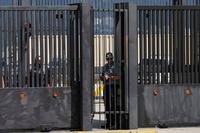ANCHORAGE, Alaska -- A program connecting troops and patients at the local Department of Veterans Affairs hospital with music therapy has been so successful that it is the subject of a summit Thursday between local military and veteran officials, state arts experts and the head of the National Endowment for the Arts (NEA).
The summit, held on Joint Base Elmendorf-Richardson (JBER), will focus on ways the program can be expanded to support more patients and families in Alaska, officials said at a reception here Wednesday.
Run as a partnership between an NEA program known as Creative Forces and the Defense Department, JBER's program has grown to 50 traumatic brain injury (TBI) and post-traumatic stress disorder (PTSD) patients since starting last summer, with about five new referrals each week, said Danielle Vetro-Kalseth, a music therapist who runs the program.
Patients enter the program through a group information session, she said. If they don't think it's the right fit for them, they don't have to continue.
Though music therapy, which can include playing instruments, drumming as a group and singing or examining and writing lyrics, might not seem macho enough for many troops or veterans, she's never had someone leave the program after the information session, she said.
"We always ask them to just come to the intake, see how you like it," Vetro-Kalseth said. "I have not had one person who doesn't continue."
Therapy sessions are offered both in groups and one-on-one, she said. She also works with speech and occupational therapists to use music therapy to help treat memory loss, fine motor skills and word recall, among other issues.
The Creative Forces program, which started almost a decade ago as a therapy program at the National Intrepid Center of Excellence in Washington, D.C., is offered at 12 bases nationwide, and NEA officials hope to expand it even further.
They also want the program here to evolve from an on-base-only offering to serving the community, with local art experts and therapists working together to help troops and veterans.
"It's not just an arts project -- it's the connection between clinical and healing arts therapy and the community piece where our service members and veterans can be in their community, be engaged and also in this arts program," said Jane Chu, who directs the NEA and is here for the summit. "We just think it's a win-win-win."
Alaska presents a unique challenge for connecting community arts programs and on-base resources because the state is so large and rural.
But connecting state-run arts initiatives, community programs and the federal program can help address that challenge, said Benjamin Brown, who heads the Alaska State Council on the Arts.
"The need is infinite, basically, compared to the resources we have," he said. "We are going to link what is currently happening at JBER with communities all across Alaska who can help."
-- Amy Bushatz can be reached at amy.bushatz@military.com.













